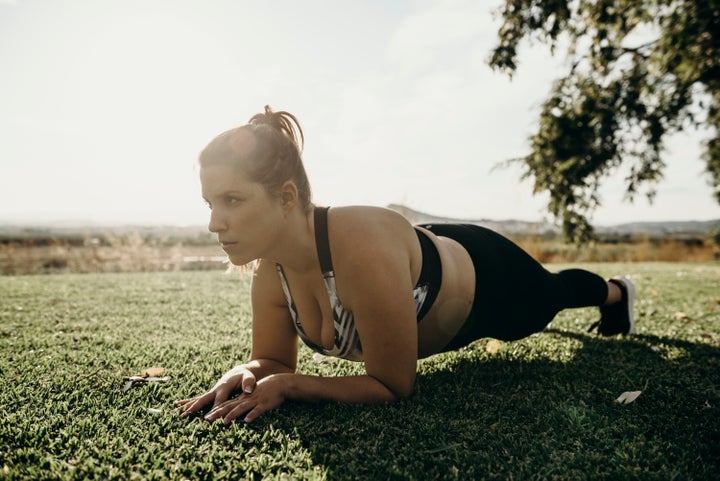You’re reading Move, the nudge we need to get active, however makes us happiest and healthiest.
Penny Weston, a fitness and nutrition expert, was first diagnosed with asthma when she started PE classes in school. She noticed running up the stairs would get her out of breath. “I avoided any sport or PE and just wasn’t active,” she says.
Weston knows how debilitating and upsetting it can be when exercise is extra difficult because of asthma, especially if you’re someone who enjoys moving your body. But what happens inside your body when you have an asthma episode, and how can you still enjoy exercise when that can happen?
What asthma looks like in the context of exercise
“A good way to picture this is to imagine trying to walk whilst breathing through a straw,” explains Dr. Paul O’Connell, a general practitioner from Cardiff, who recently launched Physical Nutrition. “When we exercise, our bodies require more air and oxygen, and this requires the lungs to work harder. If your airways are inflamed and narrow, then getting air into them (and carbon dioxide out of them) is harder.”
Asthma is about how lungs interact with the environment, too. “People with asthma have breathing tubes – airways or bronchi – that are extra sensitive to triggers in the environment,” explains Dr. Sophie Vergnaud, a pulmonologist, hospitalist and medical editor for GoodRx. “When the airways are triggered, they become swollen and tight, making it hard for air to move through them.” This can lead to bronchoconstriction, which causes “wheezing, shortness of breath, chest tightness and coughing.”
It’s important to note that there’s a difference between asthma and exercise-induced asthma (also clinically known as EIB). Vergnaud explained EIB is similar to asthma, but it only happens in response to exercise.
“It matters because sometimes, people who get symptoms while exercising get diagnosed with EIB, but they actually have asthma,” Vergnaud says. “The bottom line is if someone has EIB, they need to be formally tested for asthma.”
Is it asthma or the usual out-of-breath feeling that comes with a workout?
But wait, isn’t a little bit of breathlessness normal when you’re exerting yourself? It depends.
“You will probably need to stop, and you may find that it takes you longer than usual to recover,” Vergnaud says. “If your symptoms improve with your quick-relief inhaler, like albuterol, then that’s a good sign you were experiencing bronchoconstriction.”
Another sign, she said, is noticing symptoms starting when you’re exposed to a triggering environment (like cold, dry air) or those symptoms not improving as you continue to work out regularly (and rest!).

How to enjoy exercise with asthma, safely
Vergnaud notes that exercise doesn’t always contribute to asthma; in fact, it can help. Exercise improves lung capacity, increases blood flow and pumps oxygen through your body.
It was life-changing for Weston, who made her asthma much less severe with high-intensity interval training and other stop-and-start exercises. Plus, some athletes have asthma, including David Beckham, so it’s possible for you to exercise successfully with the condition, too.
Here’s some advice from doctors:
1. Keep up with general asthma-related self-care
First, talk to your doctor about your asthma and how to manage it. According to Vergnaud, this may entail taking your prescribed inhaler daily, quitting smoking (or avoiding people when they’re smoking, when possible) and anything else your doctor suggests in your “asthma plan.”
She also mentions avoiding triggers (more on that later), taking it easy when your asthma flares up, exercising with someone who knows you have asthma, and engaging in strength-building exercises rather than solely aerobic ones.
2. Find a moderately intense exercise you enjoy
Exercise that’s too intense, competitive or extreme can be a recipe for disaster. But here’s the good news: Plenty of exercises and sports are considered “safe,” according to Vergnaud. She mentioned hiking, swimming, tennis, yoga, biking, baseball, basketball, gymnastics, golf and dancing as options.
“Endurance sports in extreme temperatures, such as cross-country skiing, soccer or any type of long-distance racing events, can be more challenging, but not impossible,” she added.
3. Build up slowly and see how you do
While those sports and activities are generally fine to do, you still want to be mindful, especially when trying a new one.
“Once you understand your asthma and are confident that you have taken medical advice, exercise with caution and start with something like a short walk or a cycle to see how your body reacts,” O’Connell says. “As with any new exercise, build up slowly, do something achievable and reward yourself by remembering that even light exercise is better than sitting at a desk or on the sofa.”
Exercise snacking, aka moving your body for short periods throughout the day, might also be a good choice.
Additionally, O’Connell recommends exercising locally and bringing your phone (and inhaler, of course) with you in case something happens.
4. Know and avoid your asthma triggers
Your doctor probably told you some factors that exacerbate your asthma. Do your best to avoid any of them related to your workout.
“Remember that things in the environment like cold air, pollens, smoke and fumes can be triggers to asthma, so be mindful of where and when you are exercising (for example, cold early-morning air) and take your reliever medication with you,” O’Connell says.
If you love the outdoors but need to exercise indoors for your health, you could watch and listen to virtual running videos like this one that make you feel like you’re outside.
“Asthma should not be underestimated,” O’Connell says. He encourages keeping your doctor updated with your exercise habits.
As you do all of this, try to be self-compassionate, not self-critical. You’re not the only one who struggles with this, and there’s nothing to be ashamed of. Health and fitness abilities are not moral issues that can make you a more (or less) “good” or “worthy” person.
Move celebrates exercise in all its forms, with accessible features encouraging you to add movement into your day – because it’s not just good for the body, but the mind, too. We get it: workouts can be a bit of a slog, but there are ways you can move more without dreading it. Whether you love hikes, bike rides, YouTube workouts or hula hoop routines, exercise should be something to enjoy.

